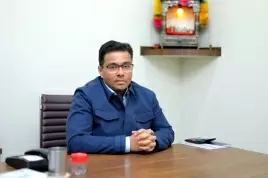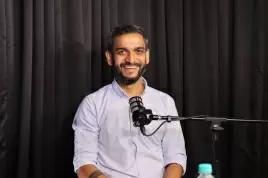Wildlife SOS took the bear away but gave the gypsy tribes a better livelihood
30-March-2012
Vol 3 | Issue 13
The desire in their eyes is apparent. It’s the desire to reclaim their lives, to do something that will give them the ability to indulge their children, or buy a trinket for themselves.
It’s the desire to dream of a life they would never have dared to otherwise. They are the Kalandar women, who come from a nomadic gypsy tribe, and have for long led oppressed, indigent lives.
 |
|
Sloth bears have been rescued from the Kalandar community and the tribe rehabilitated (Photo Courtesy: Sunny Shah, WWF India)
|
For centuries, the Kalandars, an orthodox community, have been getting sloth bears to ‘dance’ in public to earn a living. Their living conditions were pitiable, with no access to health facilities, clean drinking water, land titles or even basic education. But things started changing when the strict enforcement of the Wildlife Protection Act, 1972, rendered their trade of bear dancing illegal.
It was at the behest of Wildlife SOS, an animal welfare organisation, that the ban was enforced. Ironically, this move not only proved a blessing for the animal but the gypsy women and girls, too.
Before putting the ban into effect, Wildlife SOS knew that to uproot the bear ‘dancing’ trade they would need to rehabilitate the Kalandars. Says Geeta Seshamani, co-founder of Wildlife SOS, “It is very easy to demonise the Kalandar community, blaming them for the brutality on the sloth bears. But one has to keep in mind that they come from a very disadvantaged background. So in order to stop the trade, we had to think of rehabilitating the community.”
While a rehabilitation programme was initiated, wherein a sum of Rs 50,000 (US$1=Rs 49) was given to the owner of the bear upon voluntary surrender, it was increasingly becoming evident that in order to throw a lifeline to the community, it was important to empower its women.
So, along with setting up, in 2002, the first bear rescue centre – the Agra Bear Rescue Facility (ABRF) – the Women Empowerment Programme was started as well.
According to Baiju Raju MV, manager of the ABRF, who also works with this programme, “The Kalandar community is very conservative and does not allow their women to voice their opinion or venture out. Education for the girls is not countenanced, and they are married off by the age 12 or 13, so that families can rid themselves of this ‘liability’.”
All these taboos made the implementation of the women’s programme a tough task. “We had to break several barriers to make the women understand and realise their potential to live a better life, of the advantages of getting the girl child educated and not having her married so early, of having a second income in the family,” adds Raju.
It’s been a decade now, and their efforts have indeed proved to be life-changing, especially for young girls and women. Take Aashiya. All of 15, it was truly a landmark moment for her when her parents allowed her to go to the neighbouring school to study, a few years back.
Delighted, she even started dreaming of becoming a banker some day. But then one day, when she came back from school, she was in for a rude shock.
“My father told me that I had studied enough, and that I was to join my mother in the kitchen, while a groom was being sought for me. I was stunned! I was 14, and while I have seen many girls in my community get married at this age, I thought mine will be a different story,” recalls Aashiya.
She had been working really hard at school and her results had just started improving, when she was told to give it all up. “I cried and pleaded, but no one listened to me,” she adds.
That’s when the Wildlife SOS team, which finances the education of Kalandar children, decided to intervene. A programme coordinator paid a visit to her home: “It was very difficult convincing the parents. Their arguments were: When will she learn household work; if she gets ‘too educated’ where would they find a suitable match; and the clincher, what use will her education be if her husband does not allow her to work after marriage’.”
The programme coordinator took a long time to convince Aashiya’s parents, even arguing that education would only enable the teenager to run her family better.
When they finally relented, Aashiya went back to her studies with a fiery vigour. “I have been given this second chance and I will not let it go waste. My grades have become better and I have taken up commerce. Now I am confident that I will fulfil my dream one day,” she says.
Unlike Aashiya, Asma’s dreams are not so much for herself but for her children. Says the 30-year-old, “When my husband used to dance the bear, he used to get about Rs 500-600 a day – enough to feed a family of six. However, a greater part of the income used to go into his alcohol and ganja (marijuana) addiction. Moreover, we had to share the bear with his brothers, too, so the money was not even regular.”
Vocational training offered by Wildlife SOS came to her rescue. While Asma wasn’t sure whether learning to stitch could solve her monetary problems she went ahead with it.
 |
|
Kalandar women are scripting new lives for themselves (Photo: WWF)
|
“I was promised that after I learnt to tailor clothes properly I would be given the sewing machine. I didn’t want to let the opportunity go, so my sister-in-law and I joined the programme.”
Asma is all smiles when she says that it was the best decision she ever made, “I earn about Rs 50 every day. It may not seem much, but it means the world to me. I am no longer dependent on my husband for everything, and buy whatever I want for my children. Both my son and daughter go to school and I am also saving some money for my daughter’s wedding.” Asma’s husband, too, has found alternate employment as an autorickshaw driver in the city.
Anokhi Bibi, Asma’s sister-in-law, adds, “I am a more confident person now. I was married at 13 and was a mother at 14. I did not know of any other life; that was the life my mother and my sisters had led. Until this programme, I had thought of a similar life for my daughters, but not anymore.”
Anokhi has three children – two daughter, seven and 10 years; and a 12-year-old son. “They all go to school. Neither my husband, nor I have gone to school… we have never had lofty dreams. But I will do all I can to let my children live theirs.”
According to Kartick Satyanarayan, founder of Wildlife SOS, over 400 Kalandar women have benefitted under their empowerment programme across India.
While it is difficult to put a number, there are around seven Kalandar settlements, each with 10-12 families, around Agra alone. Efforts are also on to start a training centre in every such settlement across the country, since the community does not encourage its women to go out.
Meanwhile, Kalandar boys too are changing their ways. “A number of boys now work as informers for us, keeping us posted on any bear poaching activity or cub selling in their settlement. Of course, what is even more heartening is that a few women are involved in similar work, too,” Satyanarayan says.
Today Kalandar women are definitely scripting new lives for themselves – whether it’s by fighting child marriage and picking up a book instead, or by learning to weave and sew to provide for their families. - Women's Feature Service
















